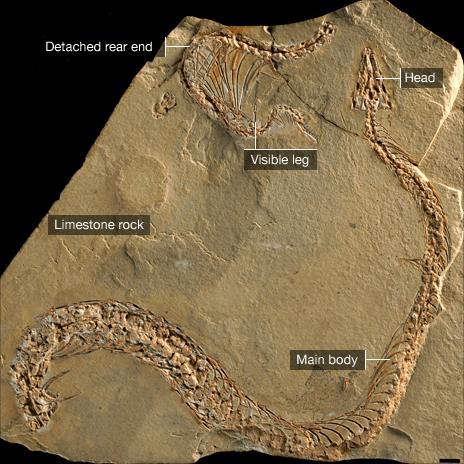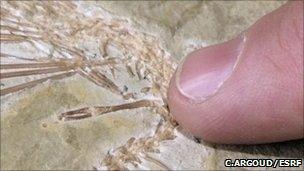Studying how snakes got legless
- Published

The snake would have slithered along the ground during the Late Cretaceous
A 95-million-year-old fossil is helping scientists understand how snakes lost their legs through evolutionary time.
Found in Lebanon, the specimen is one of only three examples of an ancient snake with preserved leg bones.
One rear leg is clearly visible but researchers had to use a novel X-ray technique to examine another leg hidden inside the fossil rock.
Writing in the Journal of Vertebrate Paleontology, the team says the snake records an early stage in limb loss.
The scientists' high-resolution 3D images suggest the legs in this particular species, Eupodophis descouensi, grew more slowly, or for a shorter period of time.
It is a conclusion made possible only after seeing all the bones obscured inside the limestone, and determining that although the creature possessed ankle bones, it actually had neither foot nor toe bones.
"This study reveals the degree of regression of the legs," said Dr Alexandra Houssaye from the Museum National d'Histoire Naturelle (MNHN) in Paris, France.

Revealed: Scientists see features on the scale of a few micrometers
"This could not be clearly determined based only on the visible leg, as some tiny bones such as ankle and foot bones might have been broken or removed from the surface. However, as all the second leg was preserved in the rock, we can now be almost completely sure of the degree of resorption of the leg," she told BBC News.
Current evidence suggests that snakes started to evolve less than 150 million years ago.
Two theories compete. One points to a land origin in which lizards started to burrow, and as they adapted to their subterranean existence, their legs were reduced and lost - first the fore-limbs and then the hind-limbs.
The second theory considers the origin to be in water, from marine reptiles.
This makes the few known bipedal snakes in the fossil record hugely significant, because they could hold the clues that settle this particular debate.
But Dr Houssaye says Eupodophis descouensi of itself cannot resolve such arguments.
"This study does not enable us to choose between the two hypotheses," she told BBC News. "In fact, a true answer might not be brought before 10 years.
"That is why our role now is to try to get as much information as possible from the few important fossil remains we have. Hind-limbed snakes are key fossils in this debate and that is why we really need to study them in detail."
The BBC was with Dr Houssaye in 2008 when she took the fossil to the European Synchrotron Radiation Facility (ESRF) in Grenoble, France.
The machine produces a brilliant X-ray beam that can pierce just about any material, revealing its inner structure in incredibly fine detail.
For this study, the fossil snake was clamped to an inclined table and rotated in front of the X-ray beam.
In a process known as computed laminography, many hundreds of 2D images were produced which were then woven, with the aid of a smart algorithm, into a detailed 3D picture. The scientists can see features on the scale of a few micrometers.

A finger points to the visible leg of the ancient snake
Eupodophis descouensi was just under a metre long. It would have slithered along the ground during the Late Cretaceous, when dinosaurs still roamed the Earth.
It is unlikely the animal would have used the legs for moving, although it is possible they could have served some other function.
In a number of modern snakes, such as boas and pythons, tiny "spurs" are evident near their rear ends that are used as grippers during sex.
The Eupodophis descouensi fossil was unearthed near the Lebanese village of al-Nammoura and was first described in 2000.
Its remains are divided across the two interior faces of a thin limestone block that has been broken apart.
A portion of the vertebral column is missing; and in the process of preservation, the rear end - with the legs - became detached and positioned near the head.
"It will be interesting to make comparisons now with other fossil specimens but also with [living] lizards and snakes with regressed pelvic and limb elements," Dr Houssaye said.